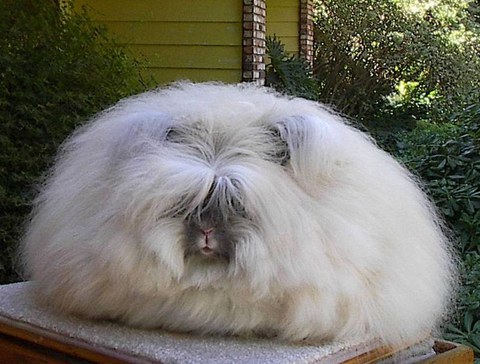Jan 13, 2024
Animals and Money: Luxurious Fibre - The Economic Value of Angora Wool Rabbits

Angora rabbits were bred to have exceptionally long hair. This hair is very suitable to produce high quality wool from. However, breeding the rabbits and harvesting the wool is debated due to animal welfare concerns.
With “Project Angora” the Nazis kept nearly 65,000 angora rabbits in more than 30 concentration camps like Dachau and Auschwitz. By 1943 the rabbits were producing more than 4,500 kg of wool. They had their own elegant hutches, scientifically prepared meals, and some of the best veterinary care possible. The cruelest thing about “Project Angora” is the fact that right next to the luxurious hutches of the rabbits, thousands of people were crammed together and brutally murdered1. This underlined how little human lives were valued by the Nazis. But why would the Nazis want to use rabbit wool and what role does it play today?
Angora rabbit fibre is a medullated fibre2, which means that its internal cells are air filled3. This makes angora hair heat-retaining and very light. The fibre is odorless4 and hypoallergenic5, making it ideal for textile end uses. As medical fabric the wool can be used as thermal underwear, in hospital blankets and also as a palliative for arthritic conditions and joint pains6,7. Angora wool also had and still has a very luxurious reputation8,9. The Nazis therefore used the wool for uniforms of SS officers.
Angora wool today is still considered a high-quality fibre. Angora rabbits produce a lot of wool for their size, especially compared to commonly used wool sources like sheep6. The amount of wool that can be taken from Angora rabbits depends on age, sex, and wool collection method10. However, wool harvest is often done in a brutal way, only to produce wool faster and more cheaply for us humans. Wool of Angora rabbits is harvested mainly by plucking or by shearing6. Plucking on commercial Angora farms is often done by pulling out small tufts of wool at the hair tips. This method is done three to six times a year and provides the longest wool fibres. This process is painful to the animals6. Shearing can be performed every three months (harvest intervals). It produces less valuable shorter wool fibres but a greater yield per year. Shearing takes eight to ten minutes per rabbit and is therefore not only relatively fast, but also less painful for the animal than plucking6. Over 90% of the world’s Angora wool is produced in China. In 2000, around 8000t wool were produced worldwide10. The Chinese rabbit wool is mainly exported to Europe (Germany, Italy, Great Britain) and Asia (India, Japan, South Korea)11.
The most recent price of Angora wool (which cannot really be generalized since different breeds produce different quality fibres and therefore the cost varies) ranges from 35 to 260 USD per kilo12,13 . With an annual production of 8000t Angora wool worldwide, a turnover of 280,000 to 2,080,000 USD would be generated. Depending on the breed, an Angora rabbit produces between 350 and 1,000 g wool per year12. With a lifespan of three years and an average price of 147 USD per kilo, the value of one individual Angora rabbit would be somewhere between 154 and 441 USD. An average Angora rabbit has a lifespan of five to eight years if treated well14. On commercial Angora rabbit farms, which mainly sit in China10, the lifespan is often shorter. The most important indicator for profitability is the feed intake-to-wool production ratio10. A paper from 2019 calculated this ratio for the harvesting intervals of Angora rabbits and identified that only the first 13 harvest intervals are profitable. With older age the animal gradually produces less wool and after harvest interval 13 farms would lose money on the upkeep of older rabbits. This would mean the upkeep of rabbits is only profitable for the first three years of their life, assuming that harvesting is done every three months. Therefore, commercial rabbits are killed after around three years10.
Even though Angora rabbit fibre has some superior characteristics compared to other animal fibres, the harvesting process is disputed. Animal welfare concerns increased when PETA released a disturbing video in 2013, showing how poorly the animals were housed and handled on commercial farms in China15. This showcase of animal cruelty also had consequences for the economy: big fashion labels responded to the scandal by stopping the use of Angora fibre for their clothing1.
In conclusion it can be said that Angora rabbits produce extraordinary wool with some advantageous characteristics and are therefore absolutely justified on the wool market. However, the welfare of commercial animals should always be considered when buying Angora wool products.
Emma Markwardt
